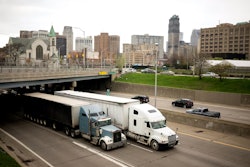American Trucking Associations confirmed it would not try to delay federal rules aimed at cutting diesel pollution. “I can tell you without reservation that ATA does not intend to challenge EPA’s diesel engine emission standards,” ATA President Bill Graves said last month. “It is very clear to ATA and the motor carrier industry that this rule will result in significant positive impacts on the quality of our nation’s air.”
CitiCapital has agreed to sell its Transportation Finance Business to GE Commercial Finance for approximately $4.4 billion in cash. The business provides financing, leasing and asset-based lending to the trucking industry. The sale is subject to regulatory approvals and could close by the end of 2004.
Guaranteed Overnight Delivery halted its less-than-truckload operations in late October. The Newark, N.J.-based private company had operated nearly 300 tractors.
Swift Transportation named Robert Cunningham president and chief operating officer and a member of the board. The Phoenix-based carrier said that it expects Cunningham to become chief executive officer by Dec. 31, 2005. He had served as Swift’s executive vice president of sales and marketing from 1985 to 1997.
USF Corp. Chairman and CEO Richard DiStasio resigned to pursue other interests last month – 14 months after taking the helm and three months after announcing a turnaround plan. The board named Paul Liska executive chairman and Thomas Bergmann interim chief executive.
TSA postpones background checks for hazmat renewals
Transportation Security Administration last month postponed until May 31, 2005, the start date for fingerprint-based criminal background checks for the transfer and renewal of hazardous materials endorsements on commercial driver’s licenses. Background checks for drivers applying for new hazmat endorsements will begin Jan. 31, 2005, as previously scheduled.
An interim final rule published Nov. 24 made various changes to the standards related to security threat assessments of commercial truck drivers authorized to transport hazardous materials. TSA required each state to declare whether it wishes to capture and submit fingerprints, applicant information and fees itself – or have TSA complete those tasks. Fees for TSA-performed information collection will depend on the number of states that ask TSA to handle the task. (See “Background check fees could top $100.”)
In addition, TSA is changing the standards to allow certain aliens who are qualified for a CDL to apply for a security threat assessment. In addition to lawful permanent residents, TSA will allow people in lawful nonimmigrant status, refugees and aliens granted asylum as long as they possess valid evidence of unrestricted employment authorization.
TSA also modified the lengthy list of disqualifying offenses. For example, it removed one felony, simple drug possession, but added the unlawful purchase, receipt, transfer, shipping, transporting, import, export and storage of a firearm or explosives. The agency also is adopting some procedural changes, including the time limits and procedures for appeals. In addition, drivers that seek to transfer hazmat endorsements from one state to another when obtaining a license in a new state will not have to undergo a new background check, subject to some restrictions.
TSA estimates 432,000 drivers will apply for a new or renewed endorsement in the first year. While the agency has estimated 2.7 million endorsement holders exist, the U.S. Department of Transportation and the U.S. Census Bureau have calculated the number of truckers carrying primarily hazardous materials to be only 500,000 to 800,000.
Although TSA issued the changes as an interim final rule, it is accepting comments until late December. For a copy of the interim final rule, visit this site and search Docket No. 14610.
Background check fees could top $100
Transportation Security Administration last month proposed fees totaling $83 to $103 for fingerprint-based background checks of drivers seeking hazardous materials endorsements on their commercial driver’s licenses. Following a change announced later last month, TSA plans to require background checks for new hazmat endorsements by Jan. 31, 2005, and for transferred or renewed endorsements by May 31, 2005.
The agency proposes that drivers who submit fingerprints and applications to a TSA agent face an information collection and transmission fee of $25 to $45, a threat assessment fee of $36 and an FBI fee of $22. The information collection fee is uncertain, TSA said, because it depends on how many states elect to have TSA handle the task rather than another party. The fee is lower as more states have TSA do it because of economies of scale. But the fee could be higher or lower than that range in states that do not elect to have TSA handle the task.
Due to the tight schedule for implementing the program, TSA required comments by Dec. 1 and said it would not extend the date. It will consider any late-filed comments if it can. For a copy of the proposed fee schedule, visit this site and search Docket No. 19605.
Supporting documents rule proposed
Federal Motor Carrier Safety Administration last month issued a supplemental notice of proposed rulemaking (SNPRM) to clarify that motor carriers have a duty under the current regulations to verify the accuracy of drivers’ hours of service and records of duty status (RODS). In recent years, some carriers have disagreed with FMCSA on the scope of the duty to verify logs and maintain supporting documents in a systematic fashion, although courts generally have backed FMCSA’s interpretations. In effect, the SNPRM would make FMCSA’s interpretations a regulatory requirement.
Among the proposed requirements is a provision that any written or electronic document used by a carrier in connection with a specific trip must include at least the driver’s name or the vehicle number so that the document can be tied to a particular driver. FMCSA proposes a new regulatory definition of a supporting document to mean “any document that is generated or received by a motor carrier or commercial motor vehicle driver in the normal course of business that could be used, as produced or with additional identifying information, to verify the accuracy of a driver’s record of duty status.” FMCSA provided a long list of examples and asked for comments on them.
The obligation to verify logs and maintain supporting documents extends to independent drivers or owner-operators while driving for the motor carrier, FMCSA said in the supporting documents proposal. The SNPRM, which modifies a rulemaking originally proposed more than six years ago, also would confirm that drivers must collect and submit to the carrier all supporting documents with the RODS. In addition, carriers must maintain supporting documents in a method that allows cross-reference to the RODS.
FMCSA also proposed a self-monitoring system based on supporting documents that would be the carrier’s primary method for ensuring compliance with the HOS regulations. In recognition of developing technologies, FMCSA proposed to permit the use of electronic documents as a supplement to and, in some cases, in lieu of, paper supporting documents.
Comments on the SNPRM are due Jan. 3, 2005. For a copy of the proposal, visit this site and search Docket No. 3706.
Law changes trucking taxes
Changes in the federal excise tax on highway tires and the elimination of quarterly installment payments of the heavy vehicle use tax are among tax changes Congress adopted in October as part of the American Jobs Creation Act of 2004 (Public Law 108-357). Although Congress was unable to complete work this year on a six-year reauthorization of highway safety and development programs, it did adopt several changes in highway-related taxes that had been considered as part of the highway bill.
The new tax law, which takes effect Jan. 1, converts the highway tire FET from a tax based on the weight of the tire to one based on the load capacity of the tire. Under the previous law, taxes kicked in at 40 pounds and increased in weight ranges. The tax on tires exceeding 90 pounds was $10.50 plus 50 cents a pound for each pound over 90 pounds.
Under the new formula, the tax generally is 9.4 cents for each 10 pounds of tire load capacity in excess of 3,500 pounds. But for biasply and “super single” tires, the rate is 4.7 cents for each 10 pounds of tire load capacity in excess of 3,500 pounds. Under the law, a “super single” tire is one that is greater than 13 inches in cross-section width and is designed to replace two tires in a dual assembly. As with the old law, there is no tax imposed on the recapping of a tire that previously has been subject to tax.
The reason for the change, according to the House committee report on the legislation, is to make it easier for the Internal Revenue Service to measure and enforce compliance.
Currently, IRS must weigh sample batches of tires to ensure compliance. But since the Department of Transportation requires the load rating to be stamped on the side of highway tires, basing the tax on load rating makes administration easier for tire manufacturers and the IRS, the House Ways and Means Committee said.
The total revenue generated by the new tax was supposed to be the same as that raised by the old one. But according to an analysis obtained by CCJ, the tax on many truck tires will increase in the range of $2.50 to $8.50 a tire, while the tax on a super single might drop by more than $25.
Another change that will affect the cash flow of many trucking operations is the elimination of the quarterly installment option for the heavy vehicle use tax, which can be as much as $550 per vehicle, depending on weight rating. According to the House committee report, the IRS has no procedure for ensuring that taxpayers that elect quarterly installment payments actually pay installments beyond the first one. Taxpayers can receive state registrations simply by making the first quarterly installment with the return. Because IRS lacks a computerized system for checking compliance, truck owners can continue to obtain state registrations on vehicles year after year by paying only the first installment.
In the case of taxpayers owning only one or a few vehicles, it is not cost-effective for the IRS to monitor and enforce compliance, the House Ways and Means Committee said. So the solution, the committee concluded, was to eliminate the ability of taxpayers to pay the use tax in installments.
The new law, which takes effect Jan. 1, also eliminates the reduced rates for Canadian and Mexican vehicles and requires taxpayers with 25 or more vehicles for any taxable period to file their returns electronically.
Texas roads lead Overdrive survey
Texas offers drivers the best interstate highways in the nation, while Pennsylvania roads are the worst, according to readers voting in this year’s Overdrive Highway Report Card survey. Despite the poor condition of Pennsylvania’s roads, it took second place in the survey in the area of most improved.
Texas also tops some other categories in the survey: most available overnight parking, best truck stops, best rest stops (tie) and best automobile drivers. Texas spends $2.2 billion annually on highway maintenance. The state has more than 48,000 bridges – more than any other state – and more than 3,200 miles of interstate.
Arkansas, topping the most improved list, is finishing its fourth year of construction. When the state finishes its interstate overhaul next year, it will have spent $1 billion.










